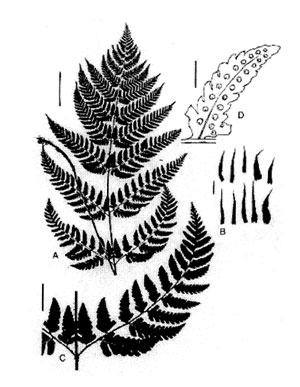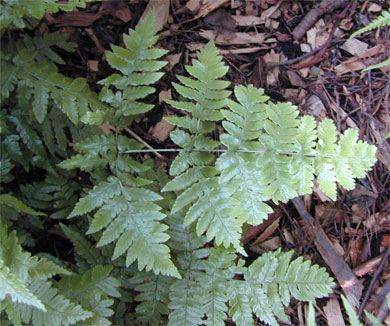| Dryopteris hondoensis | ||
|
Etymology
Hondoensis references Hondo, Japan.
Description
Rhizome: erect, bearing several fronds in a tuft, branching, scaly.
Frond: 70 cm high by 20 cm wide, evergreen, monomorphic, blade/stipe ratio: 2:1. Stipe: grooved, straw-colored, dark, scaly at base, scales lanceolate, brown, vascular bundles: 3-7 in a c-shaped pattern. Blade: 2-pinnate-pinnatifid, more on older plants, ovate to triangular, leathery, light brown, linear to bullate scales on rachis, below, absent above. Pinnae: 10 to 12 pair, opposite, the basal pinnae anadromous; costae grooved above, continuous from rachis to costa; margins margins lobed or serrate; veins free, forked. Sori: round, in 1 row between midrib and margin, extras at base of larger pinnules, indusium: reniform, gray-white early, brown later, at a sinus, sporangia: brownish, maturity: summer. Culture
Habitat: on floor of lowland forests.
Distribution: Japan, Korea and China.
Hardy to -30�C, USDA Zone 4.
Distinctive Characteristics
new growth reddish, similar to D. eythrosora, confused with it in commerce, the latter larger when mature, more arching, the crowns wider spreading, stipe scales paler, segments rounder
|
|
|
Notes
f. rubisora red indusia
f. rubisora red indusia

Dryopteris hondoensis. Fertile pinna; blowup of pinnule on the click-through. �Scan: Tom Stuart |

Dryopteris hondoensis. A) frond, bar 5 cm, B) stipe scales, bar 5mm, C) lowest pinna, bar 1 cm, D) pinnule from medial pinna, bar 5mm. �Illustration from The Cultivated Species of the Fern Genus Dryopteris in the United States, Barbara Joe Hoshizaki and Kenneth A. Wilson, American Fern Journal, 89, 1, (1999), with permission. |
